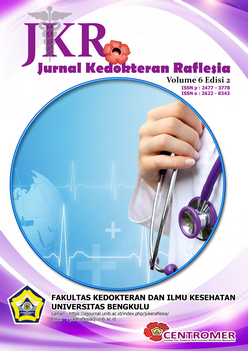Main Article Content
Abstract
Abstrak
Alergi makanan merupakan reaksi imun yang terjadi setelah paparan terhadap makanan tertentu. World Allergy Organization (WAO) melaporkan 22% penduduk dunia menderita alergi dan terus meningkat setiap tahun. Data tahun 2014, diperkirakan kasus alergi makanan terjadi pada 5% dewasa dan 8% pada anak-anak. Alergi makanan adalah bagian dari reaksi hipersensitivitas, yakni hiperesponsivitas imunologik terhadap antigen spesifik, dapat berasal dari makanan atau mikroorganisme patogen maupun produknya. Alergi makanan menunjukkan gejala klinis lokal ataupun sistemik. Perkembangan ilmu pengetahuan mengarahkan perubahan paradigma dari pencegahan alergi yang berupa tindakan menghindari alergen ke arah desensitisasi dan induksi aktif toleransi imunologik. Imunoterapi dibuat berdasarkan hubungan dengan alergen spesifik. Sebagai dasar teori yaitu dengan melakukan peningkatan paparan secara bertahap seorang penderita dengan alergen yang spesifik, maka diharapkan akan terjadi suatu proses desensitisasi atau peningkatan toleransi terhadap alergen tersebut. Oral imunoterapi melibatkan makanan yang merupakan alergen dan dikonsumsi bertahap dengan peningkatan dosis. Sebagian besar protokol oral imunoterapi meliputi fase eskalasi, diikuti dengan peningkatan dosis dan dosis maintenance. Optimasi imunoterapi dapat dilakukan dengan modifikasi protokol seperti dosis, durasi, probiotik dengan imunoterapi, ataupun modifikasi dengan alergen multipel.
Kata kunci: alergi makanan, imunoterapi
Abstract
Food allergy is immunologic reaction after food exposures. World Allergy Organization (WAO) reported 22% worldwide have allergy and keep increasing. In 2014, food allergy been speculated 5% in adult and 8% in child. Food allergy is a part of hypersensitivity, as hyperresponsiveness in immune system with spesific antigen from food. Food allergy can manifest as local or systemic. New paradigm in food allergy treatment, shifted from avoid the allergen to desensitization and tolerance. In patient with gradual exposure with spesific allergen, desensitization and tolerance been expected. Oral immunotherapy involve food consuming and increased the doses. It consist of escalation, increasing doses and maintenance. For optimizing immunotherapy, it can been modified with dosage, duration, combined with probiotic or with multiple ellergen.
Keywords: food allergy, immunotherapy
Article Details
Authors who publish with this journal agree to the following terms:
- Authors retain copyright and grant the journal right of first publication with the work simultaneously licensed under a Creative Commons Attribution License that allows others to share the work with an acknowledgement of the work's authorship and initial publication in this journal.
- Authors are able to enter into separate, additional contractual arrangements for the non-exclusive distribution of the journal's published version of the work (e.g., post it to an institutional repository or publish it in a book), with an acknowledgement of its initial publication in this journal.
- Authors are permitted and encouraged to post their work online (e.g., in institutional repositories or on their website) prior to and during the submission process, as it can lead to productive exchanges, as well as earlier and greater citation of published work (See The Effect of Open Access).
References
- Boyce JA, Assaád A, Burks AW, Jones SM, Sampson HA, Wood RA, et al Guidelines for the Diagnosis and Management of Food Allergy in the United States: Report of the NIAID-Sponsored Expert Panel. J Allergy Clin Immunol. 2014.
- Sicherer SH, Sampson HA, Food allergy: Epidemiology, pathogenesis, diagnosis, and treatment. J Allergy Clin Immunol. 2014 Feb; 133(2):291-307
- Sudoyo A W, Setyohadi B, Alwi I dkk. Buku Ajar Ilmu Penyakit Dalam. Edisi V. Jakarta. 2009.
- Oyoshi MK, Oettgen HC, Chatila TA, Geha RS, Bryce PJ. Food allergy. J Allergy Clin Immunol. 2015.
- Berin MC, Sicherer S. Food Allergy: Mechanism and Therapeutics. Current Opinion in Immunology 2011, 23:794–800.
- Wang J, Sampson HA. Food Allergy. J Clin Invest. 2011;121(3):827–835)
- Scurlock AM, Stacie M. An update on immunotherapy for food allergy. Curr Opin Allergy Clin Immunol. 2010.
- Gocki J, Bartuzi Z. Role of immunoglobulin G antibodies in diagnosis of food allergy. Postepy Dermatol Alergol. 2016.
- Akdis CA, Akdis M. Advances in allergen immunotherapy: Aiming for complete tolerance to allergens. Science Translational Medicine. 2015.
- Wood RA. Oral Immunotherapy for Food Allergy. J Investig Allergol Clin Immunol. 2017.
- Kim EH. Food Allergy Immunotherapy: Oral immunotherapy and epicutaneous immunotherapy. Allergy: 2020.
References
Boyce JA, Assaád A, Burks AW, Jones SM, Sampson HA, Wood RA, et al Guidelines for the Diagnosis and Management of Food Allergy in the United States: Report of the NIAID-Sponsored Expert Panel. J Allergy Clin Immunol. 2014.
Sicherer SH, Sampson HA, Food allergy: Epidemiology, pathogenesis, diagnosis, and treatment. J Allergy Clin Immunol. 2014 Feb; 133(2):291-307
Sudoyo A W, Setyohadi B, Alwi I dkk. Buku Ajar Ilmu Penyakit Dalam. Edisi V. Jakarta. 2009.
Oyoshi MK, Oettgen HC, Chatila TA, Geha RS, Bryce PJ. Food allergy. J Allergy Clin Immunol. 2015.
Berin MC, Sicherer S. Food Allergy: Mechanism and Therapeutics. Current Opinion in Immunology 2011, 23:794–800.
Wang J, Sampson HA. Food Allergy. J Clin Invest. 2011;121(3):827–835)
Scurlock AM, Stacie M. An update on immunotherapy for food allergy. Curr Opin Allergy Clin Immunol. 2010.
Gocki J, Bartuzi Z. Role of immunoglobulin G antibodies in diagnosis of food allergy. Postepy Dermatol Alergol. 2016.
Akdis CA, Akdis M. Advances in allergen immunotherapy: Aiming for complete tolerance to allergens. Science Translational Medicine. 2015.
Wood RA. Oral Immunotherapy for Food Allergy. J Investig Allergol Clin Immunol. 2017.
Kim EH. Food Allergy Immunotherapy: Oral immunotherapy and epicutaneous immunotherapy. Allergy: 2020.
